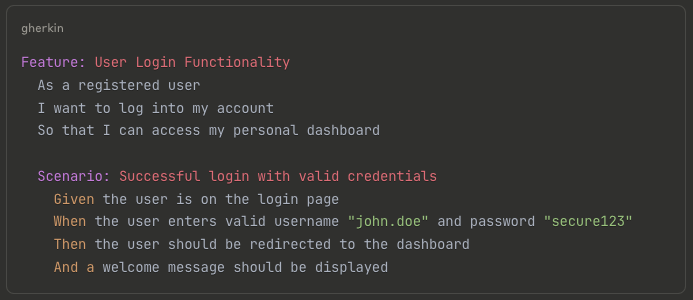Understanding Behavior-Driven Development and Cucumber Testing in 2025

Current State and Reality Check | TL;DR
While Behavior-Driven Development (BDD) and Cucumber remain viable testing approaches, their adoption is mixed in 2025. About 27% of sampled open-source projects use BDD frameworks, with prevalence highest in Ruby projects (68%). Many developers use BDD tools for purposes beyond traditional BDD, and the methodology faces practical challenges that limit widespread adoption.



The software testing landscape in 2025 presents a complex picture for Behavior-Driven Development (BDD) and tools like Cucumber. While proponents continue advocating for BDD's collaborative benefits, real-world adoption data and developer feedback reveal a more nuanced reality. Let's examine what's actually happening with BDD today.
What is Behavior-Driven Development?
Behavior-Driven Development is a software development approach that emphasizes collaboration between developers, QA engineers, and business stakeholders. BDD encourages collaboration across roles to build shared understanding of the problem to be solved, working in rapid, small iterations to increase feedback and the flow of value.
The core BDD process involves three steps:
Discovery: Teams hold structured conversations around real-world examples to explore and define expected system behavior.
Formulation: Examples are written as executable specifications using plain language that both humans and computers can understand.
Automation: These specifications become automated tests that guide development and validate functionality.
Cucumber: The Leading BDD Tool
Cucumber adoption has grown steadily for 10 years, doubling the number of users every 18 months (InfoQ interview with Cucumber founder). In 2017 alone, Cucumber was downloaded 20 million times across its various language implementations. With over 40 million downloads, Cucumber Open is recognized as a leading automation tool based on BDD framework (Qentelli analysis).
How Cucumber Works
Cucumber uses Gherkin, a business-readable language that structures test scenarios using keywords like Given, When, and Then:

This plain-language approach theoretically allows business stakeholders to understand and contribute to test scenarios while providing clear specifications for technical teams.
The Reality of BDD Adoption in 2025
Mixed Adoption Patterns
Research on open-source projects reveals interesting patterns: Results of the study indicate that ≃ 27% of the sampled projects use BDD frameworks, with a prevalence in Ruby projects (68%). However, survey respondents indicate that, while they understand the intended purpose of BDD frameworks, most of them write tests while/after coding rather than strictly applying BDD (ScienceDirect study).
This suggests that many teams adopt BDD tools without fully implementing BDD methodology—using Cucumber for test automation rather than behavior specification and discovery.
Developer Sentiment and Challenges
People keep asking me if BDD is dead. It's not, but I sincerely believe that it needs to evolve (Automation Panda blog). Several factors contribute to BDD's implementation challenges:
Maintenance Overhead: As applications grow, maintaining Gherkin scenarios can become burdensome, especially when requirements change frequently.
Tool Friction: One of the biggest pain points I've felt with BDD is the fact that feature files holding Gherkin scenarios can never truly be read and written by everyone on a team (Automation Panda blog).
Collaboration Gaps: The intended collaboration between technical and non-technical stakeholders often doesn't materialize in practice, limiting BDD's core value proposition.
Current Testing Trends Impacting BDD
AI-Driven Testing Revolution
The testing landscape is rapidly changing with AI adoption. 80% of developers now using AI tools in their workflows, though trust in the accuracy of AI has fallen from 40% in previous years to just 29% this year (Stack Overflow 2025 Developer Survey).
AI testing tools can:
- Generate test cases automatically from existing code
- Predict potential failure points
- Maintain test scripts with self-healing capabilities
- Provide intelligent test execution strategies
Shift-Left Testing Dominance
Modern development emphasizes testing earlier in the development cycle. The Shift-Left practice of adding testing during the initial part of the development lifecycle and carrying it over into the deployment phases (Shift-Right) is becoming widespread (Programming Insider analysis).
This approach often bypasses BDD's discovery phase, as teams focus on rapid automated testing integration rather than collaborative behavior specification.
Developer Experience Focus
Developer experience (DevEx or DX) refers to the overall satisfaction and feeling of productivity that developers experience when interacting with software development tools, processes, environments, and platforms (JetBrains Developer Ecosystem Report). Many development teams prioritize tools and workflows that enhance immediate productivity over collaborative methodologies like BDD.
When BDD Makes Sense in 2025
Despite challenges, BDD remains valuable in specific contexts:
Complex Business Logic
When applications involve intricate business rules that require stakeholder input and validation, BDD's collaborative approach provides genuine value.
Regulatory Requirements
Industries with strict compliance needs benefit from BDD's living documentation, which serves as auditable specifications.
Cross-Functional Teams
Organizations with strong collaboration between business and technical teams can leverage BDD's shared language effectively.
Legacy System Modernization
When updating existing systems, BDD scenarios help capture and preserve business logic understanding across team transitions.
Modern Alternatives and Hybrid Approaches
API-First Testing
Many teams focus on API contract testing and service-level validation rather than full BDD scenarios, achieving faster feedback with less overhead.
Property-Based Testing
Automated test generation that explores edge cases without requiring manual scenario specification.
Observability-Driven Development
Using production monitoring and telemetry to understand system behavior, complementing or replacing traditional testing approaches.
Practical Considerations for Teams
Honest Assessment
Before adopting BDD, teams should honestly evaluate:
- Actual collaboration patterns between business and technical stakeholders
- Tolerance for additional tooling and maintenance overhead
- Commitment to the full BDD process, not just Cucumber adoption
Gradual Implementation
BDD remains quite effort-prone, and its application goes beyond the simple adoption of a BDD framework (ScienceDirect study). Teams considering BDD should start small with critical user journeys rather than attempting comprehensive coverage.
Tool Selection
Modern BDD implementations can integrate with:
- Cloud testing platforms for scalable execution
- CI/CD pipelines for automated validation
- Reporting tools for stakeholder communication
The Future of BDD: Evolution Required
BDD needs to evolve to remain relevant in modern software development. Potential evolution paths include:
Better Tooling Integration: Seamless integration with modern development workflows and AI-assisted test generation.
Simplified Adoption: Reduced overhead for teams wanting collaborative testing without full BDD ceremony.
AI-Enhanced Discovery: Using language models to facilitate and document discovery sessions more effectively.
Conclusion: A Balanced Perspective
BDD and Cucumber represent mature approaches to collaborative software testing with proven benefits in appropriate contexts. However, their adoption in 2025 is neither universal nor without challenges. Even if the BDD frameworks usage is widespread among open source projects, in many cases they are used for different purposes such as unit testing activities.
Teams considering BDD should:
- Honestly assess their collaboration patterns and needs
- Start with limited scope to evaluate fit
- Consider hybrid approaches that blend BDD principles with modern testing practices
- Focus on business value rather than methodological purity
The most successful testing strategies in 2025 combine elements from multiple approaches—whether that includes BDD depends on specific team dynamics, project requirements, and organizational commitment to the full collaborative process.
Sources and Further Reading
- Demystifying the adoption of behavior-driven development in open source projects - ScienceDirect, 2020
- BDD Tool Cucumber is 10 Years Old: Q&A with its Founder - InfoQ, 2018
- Is BDD Dying? - Automation Panda, March 2025
- 2025 Stack Overflow Developer Survey Results - Stack Overflow, July 2025
- State of Developer Ecosystem 2024 - JetBrains
- 5 Software Testing Trends Getting Popular in 2025 - Programming Insider
- Cucumber Testing: Transforming Modern Automated Testing - Qentelli
What's your experience with BDD and testing methodologies? Have you found approaches that work well for your team's collaboration and quality goals?
This analysis is based on current industry research, developer surveys, and real-world adoption patterns. Testing strategy selection should always consider specific team needs and project contexts rather than following trends alone.
Related posts
Ready to Transform Your Business?
Contact us today to discuss how we can help with your next project or service.



